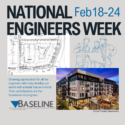Engineering Stories of the Day
 “Out of college, I was working nights as a field engineer for the Mass Department of Transportation, and when winter came and paving operations were slowing down, I was given the option to move to days and help out in the design office for the season. I really enjoyed my time working with their designers and never went back out to the field. I don’t know if I just wanted to work days or as a designer more at that point, but I’d say it all worked out in the end.” — Mike Swanton, PE, Project Manager
“Out of college, I was working nights as a field engineer for the Mass Department of Transportation, and when winter came and paving operations were slowing down, I was given the option to move to days and help out in the design office for the season. I really enjoyed my time working with their designers and never went back out to the field. I don’t know if I just wanted to work days or as a designer more at that point, but I’d say it all worked out in the end.” — Mike Swanton, PE, Project Manager
“I don’t have any really good stories yet. If I had to pick one story with a little piece of advice I would say ALWAYS take site visits. One project was totally through a preliminary design with CDs. After a quick visit to the field, it was clearly not going to work. Thus, the design had to quickly go through a total rework. Going out to the site, before actually designing the project, would have saved a lot of time and effort.” — Sean Callahan, EIT, Staff Engineer
Impressive Civil Engineering Feats from Around the World
 From the pyramids of ancient Egypt to the Qingdao Haiwan Bridge, civil engineering has made some of the world’s most impressive structural feats possible. These projects exceed what humans were thought to be capable of and push the boundaries of size, complexity, and man power
From the pyramids of ancient Egypt to the Qingdao Haiwan Bridge, civil engineering has made some of the world’s most impressive structural feats possible. These projects exceed what humans were thought to be capable of and push the boundaries of size, complexity, and man power
One the oldest and most impressive of these structures is the Great Pyramid of Giza. To this day, engineers are unsure of how the ancient Egyptians completed the 480-ft-tall masterpiece. Even with our modern equipment, it seems impossible given that the stones used in construction weighed up to 16 tons and were sourced hundreds of miles away. What makes this even more impressive is that accounts of the construction state that it was built in 10 to 20 years. It was left to the ancient engineers to figure out how to transport these blocks to the site, and more importantly, how to get them up the pyramid.
 Moving 2,000 years forward in history, the Segovia Aqueduct stands as a tribute to impressive Roman design, and is still in use today. Constructed in around 100 AD, it carries water 10 miles from the Frio River to the city of Segovia. Other than the fact that it is still intact, what makes this such an engineering feat, is that it was constructed without any mortar. Above ground it spans 2,388 feet and includes 165 arches measuring over 30-ft-tall, and in order to follow the sloping terrain, the engineers stacked two arches on top of each other so the duct could function correctly.
Moving 2,000 years forward in history, the Segovia Aqueduct stands as a tribute to impressive Roman design, and is still in use today. Constructed in around 100 AD, it carries water 10 miles from the Frio River to the city of Segovia. Other than the fact that it is still intact, what makes this such an engineering feat, is that it was constructed without any mortar. Above ground it spans 2,388 feet and includes 165 arches measuring over 30-ft-tall, and in order to follow the sloping terrain, the engineers stacked two arches on top of each other so the duct could function correctly.
 Looking at the modern age, there have been many impressive civil engineering projects such as the Brooklyn Bridge, Golden Gate Bridge, Panama Canal, and the Hoover Dam, but the one that stands out is China’s Qindao Haiwan Bridge. Built in 2011, this bridge is 16-miles-long and is currently the longest sea bridge in the world. It cut the commute between Qingdao and its surrounding suburb by 30 minutes. The engineering behind it is even more impressive as it was designed to stand up to a magnitude 8 earthquake and the impact of a 300,000 ton vessel. Construction began by building the bridge from either side and connected it in the middle in the final days of the project. The T shaped bridge is made up of 5,200 columns and weighs 450,000 tons. As technology continues to advance, our structures will only become more impressive, but the engineers are what make them possible. Along with celebrating the past and present feats of engineering, Baseline is excited to celebrate our engineers during National Engineering week for their hard work and the projects they make possible.
Looking at the modern age, there have been many impressive civil engineering projects such as the Brooklyn Bridge, Golden Gate Bridge, Panama Canal, and the Hoover Dam, but the one that stands out is China’s Qindao Haiwan Bridge. Built in 2011, this bridge is 16-miles-long and is currently the longest sea bridge in the world. It cut the commute between Qingdao and its surrounding suburb by 30 minutes. The engineering behind it is even more impressive as it was designed to stand up to a magnitude 8 earthquake and the impact of a 300,000 ton vessel. Construction began by building the bridge from either side and connected it in the middle in the final days of the project. The T shaped bridge is made up of 5,200 columns and weighs 450,000 tons. As technology continues to advance, our structures will only become more impressive, but the engineers are what make them possible. Along with celebrating the past and present feats of engineering, Baseline is excited to celebrate our engineers during National Engineering week for their hard work and the projects they make possible.
Excerpts from Baseline’s Engineer Team
National Engineers Week, celebrated annually during week of February around Presidents Day, dedicated to ensuing a diverse and well-educated future engineering workforce by increasing understanding of and interest in engineering and technology careers, this year’s event takes place February 16-22, 2020.
In honor of National Engineers Week, and the important role engineers have played in our firm’s success, we recently surveyed our infrastructure staff to learn more about the profession and their perspectives. Check out what our engineers had to say each day this week for their survey responses on why they chose this profession, what inspires them, and what advice can they offers others.
What types of projects do you enjoy most and why?
“Wastewater treatment. It is so “unglamorous” but so important to the environment. The advances in technology are now making wastewater reuse advantageous.” — John McLain, PE, CEO
“Any project that has a unique problem and requires a unique solution.” — Chris Manning, PE, Water/Wastewater Division Manager
“I enjoy projects that have a large focus on the environment and improve upon a site so that it exists with the natural environment in a positive way.” — Sarah Foster, PE, CFM, Project Engineer
“I enjoy designing and laying out sites because you are able to add a little creativity to the process.” — Morgan Clapp, EIT, Project Engineer
“I would say I most enjoy successful projects for obvious reasons. Aside from that, I enjoy projects that are related to things I enjoy outside of work such as sports, restaurants, breweries, etc.” — Mike Swanton, PE, Project Manager
“My favorites are the challenging grading projects, residential or commercial lots. Each one presents a new set of challenges and experiences that make me a better engineer.” — Sean Callahan, EIT, Staff Engineer
“As a civil engineer there is never a dull moment. The regulatory world is constantly changing and adding new entitlement challenges. Technology advancements, changing environmental conditions, and various site conditions require creativity, adaptability, good problem-solving skills and ability to think on one’s feet. As a civil engineer, despite your area of specialization, you need to be sensitive to local and environmental challenges as well as to the requirements of different construction project participants and the desires of the project owner. You need to have attention to detail while simultaneously understanding “the bigger picture.” You need to visualize conditions below the surface for buried utilities as well as above the surface creating roads, bridges, structures, and many more.” — Noah Nemmers, PE, Civil Engineering Division Manager
“I enjoy designing roads and utilities, performing calculations, and writing reports. I feel that I am good at completing these tasks and can positively contribute to the development of a project.” — Sarah Parsley, EIT, Project Engineer
“I actually enjoy the once-in-a-lifetime opportunities, those projects that are unique and difficult to solve. I also like to work with the team more than on my own so big projects with large teams are great for me.” — Kim Swearingen, PE, MBA
“I enjoy roadway and site improvement projects the most. The satisfaction comes when the construction is complete, and you see the cars on shiny new asphalt, when people are walking safely on a new sidewalk, when rain water is freely flowing into an inlet. This is when the enjoyment comes to fruition.” — Zach Henrichs, PE, Project Engineer



